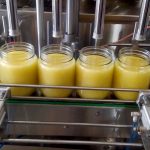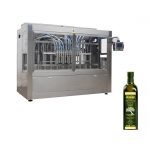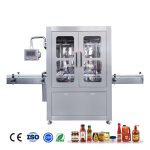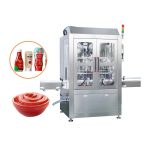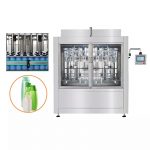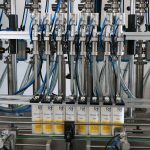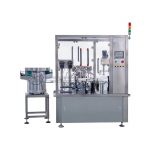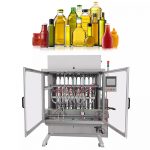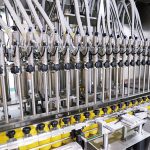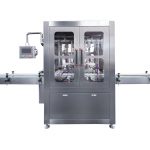What is eye drop filling machine?
An eye drop filling machine is a type of automated machine that is used to fill eye drops into containers, such as bottles or vials. These machines are commonly used in pharmaceutical manufacturing settings to fill and package eye drops and other types of liquid medications. They typically use a combination of automated mechanisms and precise measurement systems to dispense precise amounts of the eye drops into the containers, ensuring that each container is accurately and consistently filled. Eye drop filling machines may also be equipped with features such as labeling and capping systems to further streamline the production process.
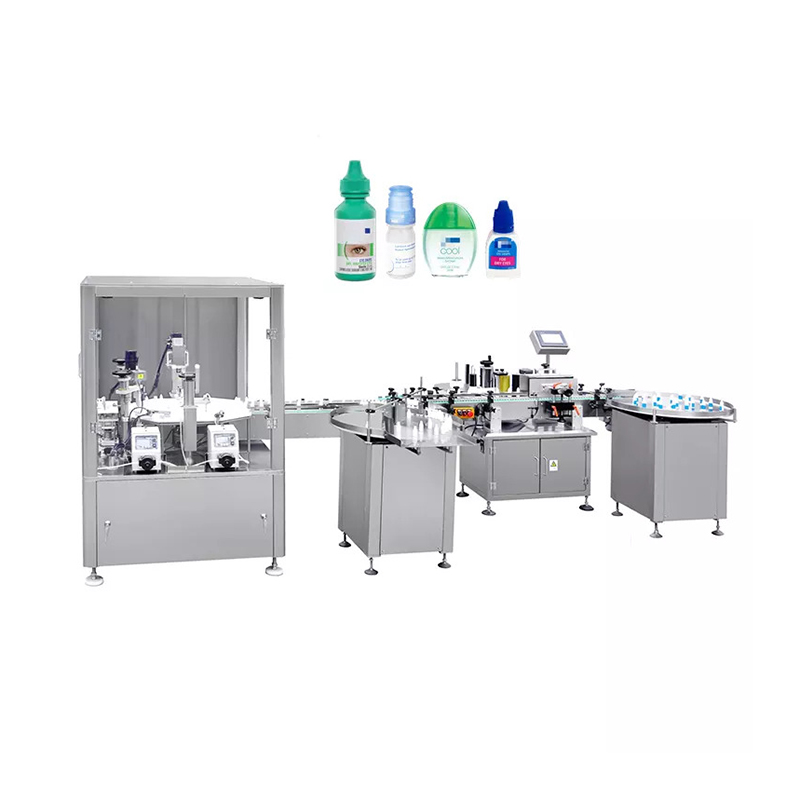
How does an eye drop filling machine work?
The specific operation of an eye drop filling machine may vary depending on the design and model of the machine. In general, however, these machines work by using a combination of automated mechanisms and precise measurement systems to dispense precise amounts of the eye drops into containers.
Here is a basic overview of the process:
- The eye drop solution is prepared and placed into a holding tank or reservoir on the machine.
- The machine is loaded with empty containers, such as bottles or vials.
- The machine is activated and begins to fill the containers with the eye drop solution. This is typically done using a combination of mechanical and pneumatic systems to control the flow of the solution and ensure accurate filling.
- Once the desired amount of solution has been dispensed into each container, the machine may also be equipped with labeling and capping systems to add labels and seal the containers.
- The filled and sealed containers are then unloaded from the machine and may be further processed or packaged for distribution.
Overall, the goal of an eye drop filling machine is to fill the containers with precise, consistent doses of the eye drop solution as efficiently and accurately as possible.
What is the capacity of an eye drop filling machine?
The capacity of an eye drop filling machine refers to the number of containers it can fill in a given period of time. The capacity of these machines can vary widely depending on a number of factors, including the size and design of the machine, the type of containers being used, and the speed at which the machine is operated.
For example, a small, manually operated eye drop filling machine may have a capacity of only a few hundred containers per day, while a larger, fully automated machine may be capable of filling thousands of containers per hour.
In general, the capacity of an eye drop filling machine is an important consideration when selecting a machine for a pharmaceutical manufacturing operation, as it will help to determine the amount of production that can be achieved in a given time period.
What types of eye drop filling machines are available?
There are several types of eye drop filling machines available on the market, ranging from small, manually operated machines to large, fully automated systems. Some common types of eye drop filling machines include:
Semi-automatic eye drop filling machines:
These machines are designed for smaller-scale production and typically require some manual intervention to operate. They may be equipped with features such as pneumatic filling systems and automatic capping systems to streamline the filling process.
Automatic eye drop filling machines:
These machines are designed for larger-scale production and are typically fully automated, requiring minimal manual intervention to operate. They may be equipped with a range of features such as labeling systems, vision inspection systems, and quality control systems to ensure accuracy and consistency in the filling process.
Monoblock eye drop filling machines:
These machines are designed to fill, label, and cap eye drop containers in a single, integrated system. They may be semi-automatic or fully automatic and are typically used in medium- to high-volume production environments.
Custom eye drop filling machines:
These machines are designed and built to meet the specific needs and requirements of a particular production operation. They may be based on existing machine designs or may be fully customized to meet the unique needs of the operation.
Overall, the choice of eye drop filling machine will depend on the specific needs and requirements of the production operation, including the volume of production, the size and type of containers being used, and any special features or requirements that may be needed.
What are the benefits of using an eye drop filling machine?
There are several benefits to using an eye drop filling machine in a pharmaceutical manufacturing operation, including:
Efficiency:
Eye drop filling machines are designed to fill and package eye drops and other liquid medications in a consistent and efficient manner. This can help to streamline the production process and increase productivity.
Accuracy:
Eye drop filling machines are designed to be accurate and consistent, helping to ensure that patients receive the correct dose of medication and that the production process is reliable and consistent.
Quality control:
Eye drop filling machines may be equipped with quality control systems and features to ensure the accuracy and consistency of the filling process. This can help to improve the quality and reliability of the finished product.
Cost-effectiveness:
Using an eye drop filling machine can be cost-effective in the long run, as it can help to increase productivity and reduce labor costs.
Safety:
Eye drop filling machines are designed with safety in mind, and may include features such as safety guards and interlocks to prevent accidents and injuries.
Overall, using an eye drop filling machine can help to improve the efficiency, accuracy, and quality of a pharmaceutical manufacturing operation, while also helping to reduce costs and improve safety.
How accurate are eye drop filling machines?
The accuracy of an eye drop filling machine refers to its ability to dispense precise, consistent amounts of the eye drop solution into containers. The accuracy of these machines can vary depending on a number of factors, including the design and quality of the machine, the type of containers being used, and the specific filling process being employed.
In general, modern eye drop filling machines are designed to be highly accurate, with some machines capable of filling containers to within 0.5% accuracy or better. This level of accuracy is important in the pharmaceutical industry, as it helps to ensure that patients receive the correct dose of medication and that the production process is consistent and reliable.
Factors that can affect the accuracy of an eye drop filling machine include the type of filling mechanism being used (such as a pneumatic system or a peristaltic pump), the viscosity of the eye drop solution, and the size and shape of the containers being used.
Overall, the accuracy of an eye drop filling machine is an important consideration when selecting a machine for a pharmaceutical manufacturing operation, as it will help to ensure the quality and reliability of the finished product.
How do you clean and maintain an eye drop filling machine?
Proper cleaning and maintenance of an eye drop filling machine is important to ensure the machine is operating at peak performance and producing high-quality, consistent products. Here are some general guidelines for cleaning and maintaining an eye drop filling machine:
Follow the manufacturer’s instructions:
It's important to follow the specific cleaning and maintenance instructions provided by the manufacturer of the eye drop filling machine. These instructions will provide detailed information on how to properly care for the machine and ensure it is operating safely and efficiently.
Clean the machine regularly:
The eye drop filling machine should be cleaned regularly to prevent the build-up of dirt, dust, and other contaminants. This may include cleaning the exterior of the machine, as well as the interior components and surfaces that come into contact with the eye drop solution.
Use the appropriate cleaning products:
It's important to use the appropriate cleaning products when cleaning an eye drop filling machine. These products should be non-toxic and safe to use on the materials used in the construction of the machine.
Follow good hygiene practices:
Good hygiene practices should be followed when cleaning an eye drop filling machine to prevent the spread of contaminants. This may include wearing protective clothing, such as gloves and masks, and following proper hand-washing procedures.
Perform routine maintenance:
In addition to regular cleaning, it's important to perform routine maintenance on an eye drop filling machine to ensure it is operating properly. This may include checking and replacing worn or damaged parts, as well as calibrating the machine to ensure it is filling containers accurately.
Overall, proper cleaning and maintenance of an eye drop filling machine is essential to ensure the machine is operating safely and efficiently, and to ensure the production of high-quality, consistent products.
What are the potential drawbacks of using an eye drop filling machine?
While eye drop filling machines can be a useful tool in pharmaceutical manufacturing, there are a few potential drawbacks to consider when using these machines:
Cost:
Eye drop filling machines can be expensive to purchase and maintain, which may not be feasible for smaller operations or those with limited budgets.
Complexity:
Some eye drop filling machines are complex and may require specialized training to operate and maintain, which can be a drawback for smaller operations with limited resources.
Dependence on machine:
Using an eye drop filling machine may make a production operation more dependent on the machine, which can be problematic if the machine experiences downtime or requires maintenance.
Quality control issues:
While eye drop filling machines are designed to be accurate and consistent, there is always the possibility of quality control issues arising. This may be due to machine malfunction, operator error, or other factors.
Limited flexibility:
Eye drop filling machines are designed to fill specific types and sizes of containers and may not be suitable for filling other types of containers or products.
Overall, while eye drop filling machines can be useful in certain situations, it's important to carefully consider the potential drawbacks and determine if the benefits of using a machine outweigh the costs and potential drawbacks.
How much does an eye drop filling machine cost?
The cost of an eye drop filling machine can vary widely depending on a number of factors, including the size and complexity of the machine, the features and capabilities it offers, and the manufacturer.
Small, manually operated eye drop filling machines may cost anywhere from a few thousand dollars to tens of thousands of dollars, depending on the specific model and features. Fully automated, high-speed eye drop filling machines can cost hundreds of thousands of dollars or more.
In general, the cost of an eye drop filling machine is an important consideration when selecting a machine for a pharmaceutical manufacturing operation, as it will help to determine the overall cost of production and the feasibility of using the machine. It's important to carefully evaluate the costs and benefits of different machines and choose the one that best meets the needs and budget of the operation.
What factors should be considered when purchasing an eye drop filling machine?
There are several factors to consider when purchasing an eye drop filling machine, including:
Production needs:
It's important to carefully evaluate the production needs of the operation to determine the type and size of eye drop filling machine that will be required. This will involve considering factors such as the volume of production, the size and type of containers being used, and any special features or requirements that may be needed.
Cost:
The cost of an eye drop filling machine is an important consideration, as it will help to determine the overall cost of production and the feasibility of using the machine. It's important to carefully evaluate the costs and benefits of different machines and choose the one that best meets the needs and budget of the operation.
Accuracy and consistency:
The accuracy and consistency of an eye drop filling machine is an important factor to consider, as it will help to ensure the quality and reliability of the finished product. It's important to choose a machine that is capable of filling containers to the required level of accuracy and consistency.
Ease of operation:
The ease of operation of an eye drop filling machine is an important consideration, especially for smaller operations with limited resources. It's important to choose a machine that is easy to use and maintain, and that does not require specialized training or expertise to operate.
Maintenance and support:
The maintenance and support provided by the manufacturer of an eye drop filling machine is an important factor to consider when purchasing a machine. It's important to choose a manufacturer that offers good technical support and can provide timely maintenance and repair services as needed.
Overall, it's important to carefully evaluate the needs and requirements of the operation and choose an eye drop filling machine that meets these needs and fits within the budget of the operation.
Are eye drop filling machines suitable for use in a pharmacy or medical facility?
Eye drop filling machines may be suitable for use in a pharmacy or medical facility, depending on the specific needs and requirements of the facility. These machines can be used to fill and package eye drops and other liquid medications in a consistent and efficient manner, which can be helpful in a busy pharmacy or medical facility.
However, it's important to carefully consider the suitability of an eye drop filling machine for a particular pharmacy or medical facility before purchasing one. Factors to consider may include the volume of production, the size and type of containers being used, the accuracy and consistency required, and the budget and resources of the facility.
In general, eye drop filling machines can be a useful tool in a pharmacy or medical facility, but it's important to carefully evaluate the suitability of the machine for the specific needs and requirements of the facility.
How do you ensure compliance with regulations when using an eye drop filling machine?
There are several steps that can be taken to ensure compliance with regulations when using an eye drop filling machine:
Follow the manufacturer's instructions: It's important to carefully follow the manufacturer's instructions for operating and maintaining the eye drop filling machine to ensure it is being used safely and correctly.
Follow good manufacturing practices (GMP): Good manufacturing practices (GMP) are guidelines that outline the standards for the production and testing of pharmaceutical products. It's important to follow GMP guidelines when using an eye drop filling machine to ensure the quality and safety of the finished product.
Follow local and national regulations: It's important to familiarize yourself with local and national regulations related to the production and packaging of pharmaceutical products and ensure that the eye drop filling machine is being used in compliance with these regulations.
Use appropriate cleaning and maintenance procedures: Proper cleaning and maintenance of an eye drop filling machine is essential to ensure the quality and safety of the finished product. It's important to follow the manufacturer's instructions for cleaning and maintaining the machine and to use the appropriate cleaning products to prevent contamination.
Perform quality control checks: Regular quality control checks should be performed to ensure that the eye drop filling machine is operating correctly and producing high-quality products. This may include checking the accuracy of the filling process and performing regular maintenance on the machine.
Overall, it's important to follow best practices and guidelines when using an eye drop filling machine to ensure compliance with regulations and to produce high-quality, safe products.

